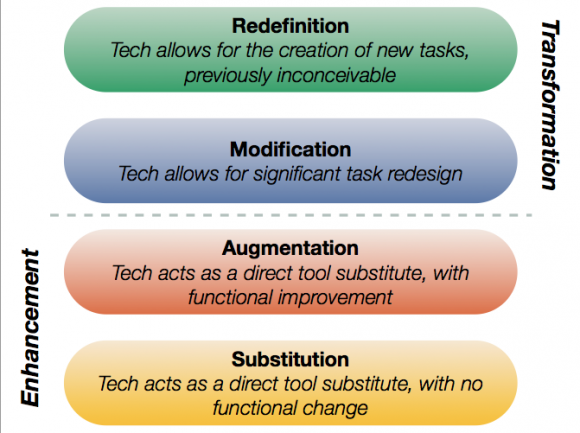
Connected Devices Supersede Textbooks
So Wednesday’s blog post about iPads has created a bit of a conversation. Not only on the blog but on Twitter as well. I have even had schools asking me to review what they are doing and give my opinion.
Now…let’s be clear, any program that puts devices in every hand of every student is a great program. My hope is we can get to a place by 2015 (or sooner) where this stops being a conversation because it just is. It’s just about past time for a device to replace paper and pencil at a substitution level and then build from there.
At the same time what a connected device does (any device connected to the Internet), is change the learning landscape. If you implement a 1:1 program and the classroom doesn’t change, then the device sits at a substitution level and never reaches its full potential as a learning device. When you introduce a connected device in the classroom, learning changes…it has to…..otherwise why have it?
Lynn University tweeted me earilier this week:
@victormylonas @jutecht That’s an old article—we bought all freshman iPads ourselves. More recent: http://t.co/CVfAtHRlaa Your thoughts?
— Lynn University (@LynnUniversity) September 5, 2013
So I went and read through the article they sent me.
There are some good quotes in the article:
“The price point will probably force schools to provide the devices to students, as the cost of hard copy textbooks go up and the cost of technology goes down,” said Chris Boniforti, chief information officer for Lynn “You’re better off giving every student tablets than buying all these books that will be obsolete in two or three years.”
National studies have shown that the cost of textbooks has risen more than three times the rate of inflation during the past 35 years. A 2011 study from the U.S. PIRG, a consumer advocacy group, found that 70 percent of students at 13 colleges surveyed admitted to not buying at least one of their required textbooks.
You can read it for yourself and what I think the article is hinting at is that the iPad isn’t replacing textbooks, it allows students a whole new way to access information. It also provides, what I hope, is professors a way to use the Internet and the wealth of fresh and up to date information to create their own “textbook” for their classes.
Connected devices don’t replace textbooks…they destory them. The last thing I want my students to do is to have a connected device and then have a traditional textbook on it. The Internet is full of resources that allow educators and students alike to create new learning opportunites that go way beyond what a textbook ever could offer.
This should be a given with any 1:1 program. Connected devices supersede textbooks…OK….then what?
That’s the question I want to know…what happens after we have replaced the textbook?
These devices don’t just replace textbooks they take learning to a whole new level of thinking, searching, creating, and organizing that we just could not do before we gave them to students.
If at any time you could take the device away from students and learning and outcomes could still be met then we haven’t pushed far enough. Look again at the SAMR model and take it straight from the founder’s website:
Redefinition: Technology allows for new tasks, previously inconceivable.Â
That’s what we should want for these devices and our students. Sure they are going to substitute a lot of tasks…but that shouldn’t be our aim. Our aim should be to redefine the learning experience and do things that would be inconceivable if the technology was taken away. To do this it means starting from the bottom and creating new learning tasks. Only then do we really reach the full potential of what these devices can do.
In our COETAIL program the final project for graduates is to reach for this redefinintion level. Not all make it but they try..and it’s hard…there are a lot of things in your way. Here are two examples of what I believe redefinintion looks like. Take the technology away from these two units/classrooms and you can not replace the learning with something else…you would actually lose learning and engagement.
So….what I want to know is how often do you, your teachers, your school or your district reach for redefinition? That’s the question I like to ask…that’s what I like to push towards, and that’s what I strive for every time I present. The worse that can happen is that you fail…and that my friends is what they call learning.
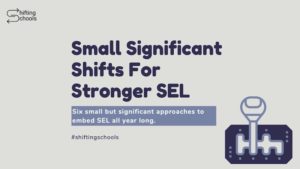
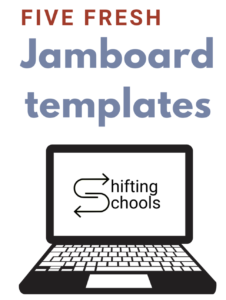
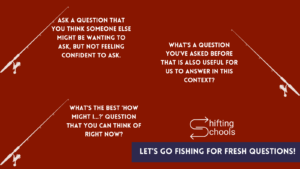
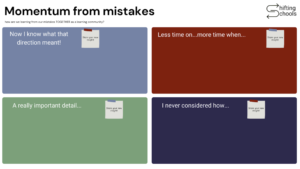



Hi, I am Morgan Rushlow and I am a student in EDM 310 at the University of South Alabama. I thought this post was very interesting. I do believe digital technology will soon replace traditional textbooks and it will change education for the better. I believe it will open a new and exciting world for students.
Here’s a link to my edm 310 student blog- http://rushlowmorganedm310.blogspot.com
and my twitter address-https://twitter.com/morganrrushlow
I think it’s amazing that there is so much technology out there that many educators are afraid to use because they don’t want to “lose” the classroom. There are many tools that will help facilitate the transition from traditional to technological. One which I just read about today is Universal Design for Learning. The technology itself just serves as a tool and extension for learning, allowing for deeper and richer learning opportunities. But, in order for it to be meaningful, to both the teacher and the student, the technology has to used in a meaningful and thoughtful manner.
This school year I am experiencing two “novel†things: a newly implemented BYOT program, and electronic textbooks. Note, however, that there was no relationship in the decision making process to adopt these. The BYOT program was implemented with the aim to provide students with new and better learning experiences. The electronic textbooks were ordered because of the convenience of a “fast†delivery in comparison to shipment time and cost when buying hard copies of the same textbooks. I have found these two experiences to be contradictory in essence. I spent a considerable amount of time just to set up my students’ accounts. This was a tedious and time consuming process. Worse yet, I feel guilty having students use their devices to access a textbook that, if anything, it is more poorly organized than the paper copy. I think I can make a better use of my planning and teaching time than figuring out how to navigate a traditional textbook online. It will sure take some time and effort to create my own “bank†of learning opportunities, but I am up for the challenge.
Ah….the the issue with textbooks online is just that. Taking traditional text and thinking that it translates online with out updating. Yes…a traditional textbook that happens to be digital is horrible…really really bad. It’s like taking a hand written essay, scanning it to a blog post and saying that’s the same thing…it isn’t. However…you creating your own “textbook” for lack of a better word out of the resources you can find and collect on the web is…well….exactly what this new connected world is about.